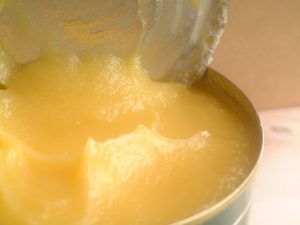- You have no items in your shopping cart
- Subtotal: ₹0.00
Cow Ghee versus Buffalo Ghee: Benefits & Uses
Cow Ghee versus Buffalo Ghee: A Comprehensive Comparison
Explore the differences between Cow Ghee and Buffalo Ghee and discover which is better for your health and daily needs.

Ghee, or clarified butter, is a staple in many households, especially in India, where it holds cultural and spiritual significance. Made from either cow or buffalo milk, ghee plays a crucial role in cooking, Ayurvedic medicine, and religious rituals. As the world’s largest producer and consumer of ghee, India offers a variety of ghee types, each with distinct characteristics. But how do Cow Ghee versus Buffalo Ghee compare? Let’s dive into the details.
Key Differences Between Cow Ghee versus Buffalo Ghee
Color and Appearance
Cow Ghee is easily recognizable by its yellowish hue, which is due to the presence of beta-carotene, a precursor of Vitamin A. In contrast, Buffalo Ghee is white and creamier in texture, making it suitable for certain culinary uses.
Ghee Yield
The amount of ghee extracted from buffalo milk is typically higher than that from cow milk. This is due to the higher fat content in buffalo milk, which produces more ghee.
Health Benefits and Fat Content
While both types of ghee are nutritious, Cow Ghee is often preferred for its lower fat content and high levels of cholesterol, making it a heart-friendly option. On the other hand, Buffalo Ghee, with its higher fat content, is richer and more energy-dense, which might not be suitable for those monitoring their fat intake.
Shelf Life
Buffalo Ghee has a longer shelf life due to its higher fat content, allowing it to be stored for extended periods without spoilage. Cow Ghee, however, should be consumed within a shorter time frame.
Suitability for Children
Cow Ghee is often recommended for children due to its lower fat content and ability to reduce obesity and protect against various health issues such as thyroid disorders and cardiovascular diseases.
Impact on Fitness
For those looking to manage their weight, Cow Ghee is a better option as it contains less fat, aiding in weight loss and overall fitness. Buffalo Ghee, while nutritious, is better suited for those who require more energy or are looking to gain weight.
Culinary Uses
Both types of ghee are used in cooking, but their applications can vary. Cow Ghee, with its lighter texture, is ideal for making sweets, curd, and light dishes. Buffalo Ghee, being thicker and richer, is perfect for making paneer, yogurt, and heavier curries.
Nutritional Content
Cow Ghee is rich in essential vitamins like A, D, E, and K, along with minerals such as calcium and protein. Buffalo Ghee, while also nutritious, is particularly high in calcium, magnesium, and phosphorus, making it an excellent choice for bone health.
Digestive Benefits
Cow Ghee is known for its ability to enhance digestion. Consuming a spoonful of Cow Ghee with a glass of warm milk before bedtime can significantly improve digestive health.
Ayurvedic Uses
In Ayurveda, Cow Ghee is often used in Nasya treatment (nasal drops) to treat various conditions like hair fall, headaches, and vision problems. Buffalo Ghee, while beneficial, is less commonly used for these purposes.
In conclusion, while both Cow Ghee and Buffalo Ghee have their own set of benefits, Cow Ghee is often regarded as the superior choice for its medicinal properties and suitability for all ages. It’s especially beneficial for heart health, children, and those looking to maintain a healthy weight. For more information on the differences between Cow Ghee versus Buffalo Ghee, check out our detailed comparison on Cow Ghee vs. Royal Ghee.
If you’re looking for the highest quality Cow Ghee, visit GheeStore today, where we offer a wide selection of pure, traditionally made ghee that caters to all your health and culinary needs. For more insights and updates, follow us on Facebook and LinkedIn.
